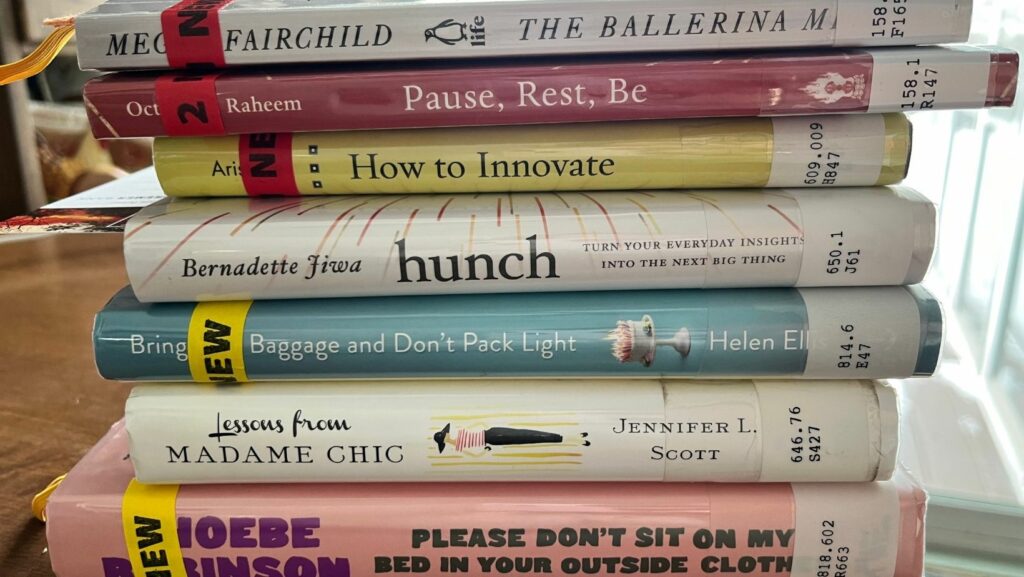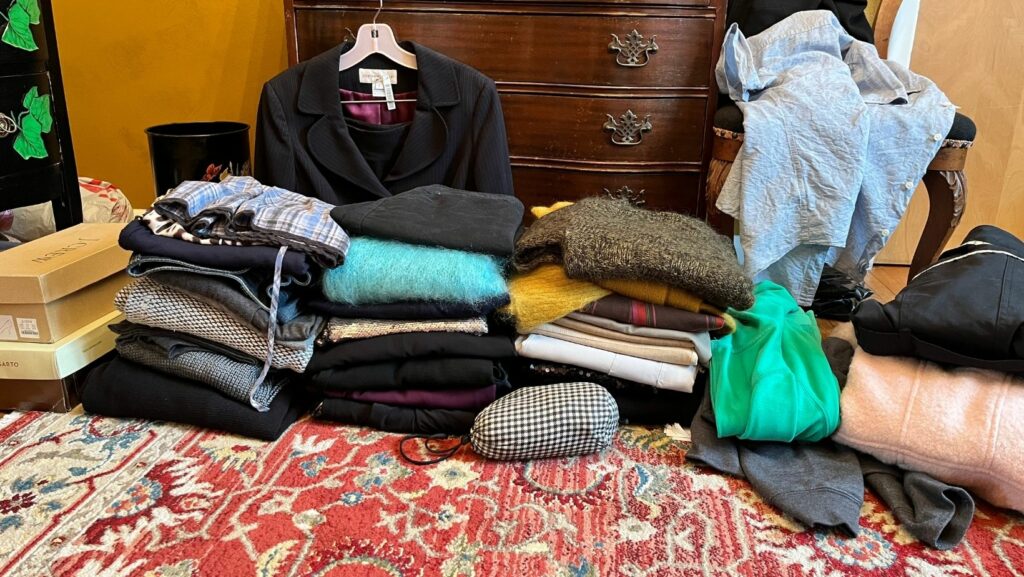On Saturday, Dr Marry and I did what we often do: we walked downtown (how else can we justify the treats we inevitably purchase???). We went for lunch, we stopped in a few shops and we went to the library where I scoured the new non-fiction and the self help/self improvement sections for covers that jump out at me for one reasons or another, usually because of jacket color, size of the actual book (the smaller, the better because I love small art, books and pitchers [see main photo]) and/or interesting title, preferably by a woman.

Last week, I was, as previously noted, all out of sorts. I had an important realization on Saturday: I didn’t have a book that had really hooked me, and that matters to my *mental health. I started to feel some of the tension leave my body and mind just being in the library with all the possibilities at my fingertips. I eagerly came home and jumped right into Lessons from Madame Chic by Jennifer L. Scott. And within a matter of moments, I felt better about everything.
This book is not new; it was published in 2011. It also didn’t exactly present any new ideas, but you know how sometimes you read the right thing at the right moment and you have a different response to it? That was this book for me.
I’m not going to go into the back story—read the link on the book title for that. But I do want to share three of the lessons that resonated for me, particularly coming out of my COVID sweatpants/jammies dress phase (ok, to be honest, I can’t blame COVID on the jammies dress phase, that was in place long before COVID was a thing.)
Chapter 8: Look Presentable Always
See previous paragraph for exhibit A. Ugh!
Exhibit B is “Avoid telling yourself you’re ‘just going to the grocery store’ (or wherever it is you happen to be going) as an excuse to look like a complete frump. You may think you won’t see anyone you know—but trust me, you will. You’ll see your ex-lover and your frenemy” (105). All the times I’ve run into people over the years when I’ve gone out with that mindset suddenly flashed before my eyes. Shudder!
So this week, when I had a lunch meeting, I thought, “Don’t you dare put on that stupid jammie dress because you’ve convinced yourself that it’s cute with tights and boots. Snap out of it!”
Instead, I went with a version of what I used to call my “signature Dayna Del Val” look: a sweater, simple skirt, tights and low-heeled boots because I was walking a mile to the lunch (incorporating exercise into your daily life is another great point of the book).

There’s nothing flashy about my signature look, but it has clean lines, it’s comfortable without looking sloppy, it’s professional, I can (and often have) go to a donor meeting and then come home and shovel the end of the driveway in an outfit like this. Win-Win!
It felt good to be back in my old look. And I’ve dressed up a bit every day since reading this, even on the days when I’m working from home with no meetings, virtual or in person. It does shift how I think about and more through my work day.
Chapter 4: Liberate Yourself With the Ten-Item Wardrobe
By many people’s standards, I don’t have a ton of clothes, but I have more than I need, and I have more than I wear. I’ve often read about the capsule or essential closet—only your most cherished 10-20 items that you can effortlessly mix and match. No thank you.
Ms Scott notes, “While in Paris, I observed the beauty of the ten-item wardrobe. I noticed that the French people whom I saw on a regular basis wore the same clothes in heavy rotation—unapologetically and with great panache” (43). She continues, “You can learn a lot about yourself and your style—what your wardrobe needs, why you resist wearing your nicest things, and how you want to present yourself as a person” (45).
I was in. You may know that I’ve hardly shopped for four years now. I can count on two hands the clothing items I have purchased, so I don’t suffer from needing new things to keep me going. (Let’s not address the jammie-clad elephant in the room and ignore the fact that I’ve had 5 of the same dress in different colors over these years, ok?)
Here’s what I moved out—effortlessly, I might add. Some of these things are 10+ years old. Do they still fit? Yes. Do I still wear them? Only occasionally. In many cases, not enough to justify keeping them.

Chapter 1: Snacking Is So Not Chic
I primarily work from home, and have done so for the last two years. And before I worked at my current job, a million years ago, I also primarily worked from home, so I am very comfortable in this environment. But, in addition to working well from home, I tend to snack well from home, too. Nearly every time I go through the kitchen, which is kind of the central hub of every corridor in our home, I can easily grab a handful of this, a few of that…all day long.
Ms Scott makes a number of interesting points about the French kitchen in the apartment where she was an exchange student in college: their kitchen was not part of an open-floor plan. Instead, it was down a long hallway that was out of the way to the rest of the house. The kitchen was purely functional as opposed to the heart of the home. She says, “The French do not eat while on the run…The only people you see eating and walking at the same time in France are tourists” (8). How often do you grab something to eat while driving, watching tv, scrolling through social media and more? She continues, “Family Chic made meals a priority and enjoyed them ritualistically…Every day they enjoyed real food. Their meals were rich, decadent, and very traditionally French” (10).
This struck me. I pass through the kitchen dozens of times every day. I eat mindlessly while “working.” I grab and go all the time. Not anymore.
I wanted to find out more about Jennifer Scott, so I looked up her website, The Daily Connisseur. I came across a video where she made this little afternoon treat to have with her tea, served in a real teacup and saucer, I might add. It’s not that the treat is so high quality (after all, she used softened ROLOs for heaven’s sakes!), but it was that it was intentional. I immediately went to purchase higher end dark chocolate with caramel and sea salt to make my own. Turns out, if you do something even this marginally more intentional than just mindlessly eating something, you eat fewer of them and you enjoy them while doing so.

There are all kinds of other lessons to glean from this funny little book. A different me would have dismissed almost the entire thing as being a book from a woman of such incredible privilege that it was impossible to take any of it seriously. But this me read it and thought, “Yes, I should sit up straighter. Yes, I should use our nicer dishes more often. Yes, I should actively reject clutter.”
And guess what? So far, I’m doing it.
C’est magnifique!
Had to go back in and add this photo from the ones I made today. They do taste better when served on a little china plate, but I like the other ones better because I used the chocolate brand Chocolove. These Ghirardelli squares are a bit too big and intense for me.

*I don’t use the phrase “mental health” lightly. I know there are people with true mental health issues, and I am not one of them. BUT, I do function better, emotionally, cognitively and even physically, if I have a book that makes me want to find those moments early in the morning and right before bed where I can get absorbed in something compelling, page after page after page.






